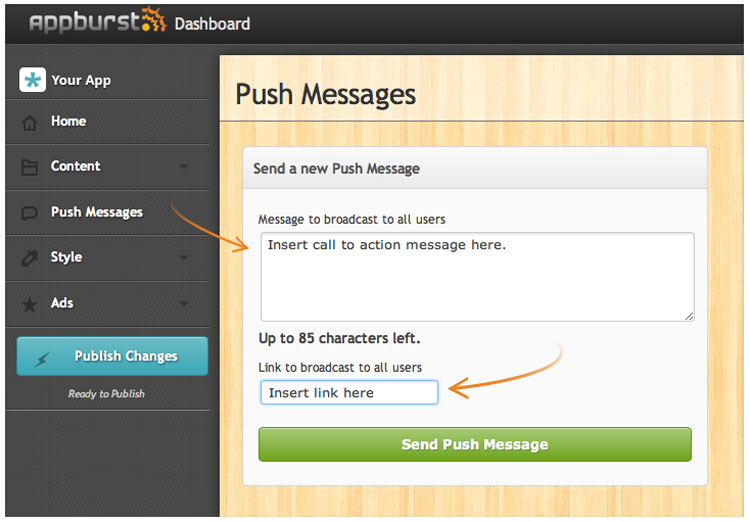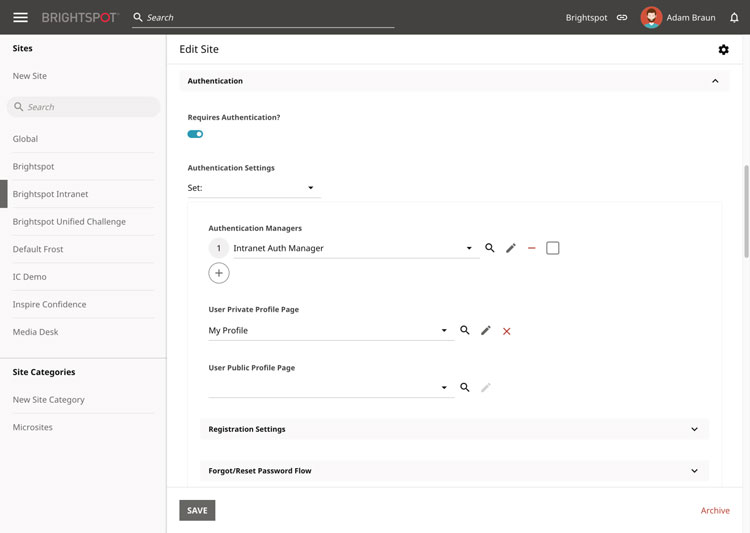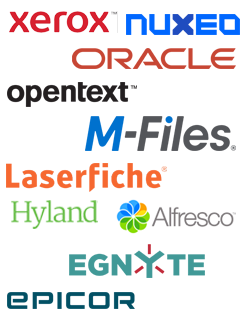Gone are the days when complex coding was the only way to build a website. With the advent of CMS, or content management systems, businesses no longer have to worry about backend coding, creating templates or hiring programmers to create and publish their content.
More than 78 million websites currently on the internet are built using CMS. But how do you know what CMS is right for your business? In this article, we’ll go over the most important content management system requirements, to give you a starting point for your software search.
Get our CMS Software Requirements Template

Article Roadmap
What Is CMS?
A content management system is a software application that helps manage digital content like blog posts and web pages. Employees can use this system to create, modify, organize and publish content. Administrators can use tools like automation and adjustable permissions to organize content and ensure data is protected.
In addition to managing your own website, a CMS allows you to maintain a consistent digital experience across multiple channels, including mobile apps and social media.
A CMS has two components:
- Content Management Application: An interface to create, edit, design and remove content from your website. These are generally user-friendly and don’t require any HTML knowledge to use.
- Content Delivery Application: The back-end service that publishes and maintains your website. It takes the content components from the CMS repository and uses metadata to display them to the website audience.
Key Requirements
The first step in looking for the right CMS for you is figuring out what your company needs. How do customers interact with your website? How do they consume your content?
Every CMS is different. Some are better suited for bloggers (WordPress being the most popular), while others may have capabilities that are more useful for eCommerce sites (like Squarespace). Whatever your needs may be, we’ve put together a list of the most essential content management system requirements to be on the lookout for.
1. AI-based Capabilities
AI has become more prevalent in many industries, with digital assistants, chatbots and recommendation engines becoming a crucial part of customer support. AI capabilities are not just limited to serving customers — they can also streamline how you manage content.
AI-powered image recognition, for instance, can tag and categorize images within seconds, reducing the need for you or your employees to manually tag and sort media. AI can also analyze the tone and topic of content through functionalities like sentiment analysis and keyword extraction. This allows it to make suggestions about how to express your message better to your audience, as well as how to improve your SEO strategy.
- AI-based Classification
- AI-based Content Capture
- AI-based Content Recommendations
- AI-based Content Search
- AI-based Tagging
- Intelligent Indexing
2. Collaboration
Collaboration is a necessary part of any workplace. But with workforces becoming increasingly remote and distributed, it can sometimes be difficult to track who’s working on what.
CMS reduces the potential for confusion by letting users collaborate on the same content in real time. Document co-authoring allows multiple users to work simultaneously on one file, with support for a variety of file types, including Excel, PowerPoint and Word. The multi-workspace option allows even employees across multiple departments to access and work on content from the same central repository.
- Announcements
- Document Co-authoring
- Email Communication
- Multi-workspace
- Text Communication
3. Compliances
Many CMS systems have data security capabilities that not only protect your company’s information, but also are in compliance with privacy standards that can vary by state or locale. These include GDPR, CCPA and PII.
GDPR, or General Data Protection Regulation, regulates data privacy across the E.U. Similarly, the California Consumer Privacy Act, or CCPA, gives California residents increased transparency and control over how organizations collect and use their data.
PII, or Personally Identifiable Information, is more broad than the previous two. This regulation was put in place to protect the integrity of your identity and safeguard your personal information from misuse. PII includes your name, address, date of birth, telephone number, social security number and other similar details.
Having a CMS that complies with all three ensures your data is protected and that you can effectively serve clientele across the globe with your website.
- Data Privacy Standard (GDPR, PII, CCPA)
- FIPS 140-2 Compliance
- ISO/IEC Standards
- Record Management Standard
- WebDAV Compliance
4. Content Capture
Another important CMS requirement is intelligent content capture, which extracts, processes and organizes data. Optical character recognition (OCR) scans and identifies text or other components based on set criteria in uploaded documents and images, eliminating the need for manual data entry.
You can also convert physical paper files to electronic versions, individually or in large batches. Batch scanning is especially helpful for organizations that deal with large volumes of paper files, as it automatically groups documents, assigns index fields and sends them to the appropriate locations in the repository, making them searchable within seconds.
- Barcode or QR Code Recognition
- Batch Scanning
- Bulk Report
- Custom Webforms
- Data Extraction
- Email Import
- On-demand Scanning
- Optical Character Recognition (OCR)
- Scheduled Import
5. Document Management
Document management captures, tracks, and stores electronic documents and files. It streamlines information search and retrieval and ensures data security.
Some of the standard requirements under document management include a centralized repository, document version control, a drag-and-drop interface and full-text search. Let’s go over these important subrequirement in more detail.
Centralized Repository
Sharing information between multiple departments and through multiple channels can be challenging, especially if most of the content is unstructured. A centralized repository acts as a unified content database that stores and organizes your files for easy access. It supports multiple document types like JPG, TIF, PDF, HTML, GIF and more.
Document Version Control
When several individuals or teams collaborate on a file, version control tracks and keeps record of the various drafts. It offers an audit trail that you can refer to, giving you more insight into how the final version of the document was formed.

Viewing the version history of a document. Source
Employees can work together without accidentally undoing or duplicating each other’s work, resulting in more effective collaboration.
Drag-and-Drop Interface
According to Zippia, as of 2021, only 36% of websites are hand-coded. A drag-and-drop UI allows you to create and edit documents no matter what your level of technical coding expertise is. You can select pre-designed layouts, templates and other elements to tailor your website to your and your customers’ needs.
Full-text Search
A more intelligent search engine, this subrequirement examines all the words in a document or section of the document repository as it attempts to match your search criteria.
- Add Comments or Annotations
- Autofill Keyword Search
- Barcode or QR Code Generator
- Centralized Repository
- Collect eSignature
- Configurable Retention And Disposition Policy
- Content Editor
- Content Federation
- Custom Metadata
- Document Comparison
- Document Organizer
- Document Preview
- Document Publishing
- Document Request
- Document Review and Approval
- Document Routing
- Document Tracking
- Document Version Control
- Drag and Drop Interface
- File Converter
- File Sharing
- Full-text Search
- Image Editor
- Labeling or Tagging
- Physical Record Tracking
- Print and Download Document
- Save Searches
- Templates Library
6. Document Protection
Document protection not only applies to keeping your data safe, it also ensures your files are accurate, organized and up to date.
Content archives help you maintain comprehensive records in the case of legal or compliance issues. They also support general record-keeping, allowing you to repurpose content as and when required, and gain insight into content performance. Built-in analytics tools track metrics related to engagement, so you can view how a piece of content performed over its publication and how engagement increased or declined.
Document protection tools can also detect duplicate documents, reducing the time and labor costs of storing and sifting through redundant files. Employees can easily check if specific files exist or not so they don’t waste time creating duplicates.
If your business publishes large volumes of content, especially visual media, then protecting it with watermarks is imperative. This safeguards your content and gives you claim to ownership over it if someone tries to steal or copy it.
- Content Archiving
- Content Readaction
- Duplicate Detection
- Legal Hold
- Lock Documents
- Watermarks
7. Mobile Capabilities
Mobile capabilities expand on your content management system’s range. There are 6.6 billion smartphone users in the world, including your customers and potential leads — why not cater to them directly?
Many content management systems are either mobile-focused or have mobile capabilities as an add-on capability. This requirement is important because of how it expands your reach and range.
Mobile media capture tools, for example, allow anyone with access to the CMS to upload, publish and manage content from their smartphones or tablets, so they can work from anywhere with an internet connection.
Publishing a mobile-friendly version of your website makes it easier for your customers to interact. You can enable push notifications to send relevant, personalized messages to website visitors, without the need to collect their personal information.

Entering information to send push messages.
Mobile capabilities also mean more convenience for your clientele. For example, you can remotely collect legally-binding eSignatures to expedite a document or contract approval process, eliminating the need to send paper documents back and forth. According to Pro Faceoff, this practice reduces time spent viewing and signing documents by 40%.
- Access Electronic Forms From Mobile
- Document Capture From a Mobile Device
- Mobile eSignature
- Native Android and iOS Applications
- Offline Mobile Access
- Push Notifications
- Responsive Web Designs
8. Platform Capabilities
A robust CMS solution will maintain a chronological record of all administrative and user actions, with the ability to generate detailed reports as needed. Audit trails track all the actions on the interface, maintaining transparency and increasing accountability in your organization. Permissions are assigned to users based on roles, so you can ensure your employees have access to all the documents they need and none that they don’t.
Another useful CMS capability is single sign-on, or SSO. It’s an identification method that enables users to log in to multiple websites or applications with a single set of credentials, simplifying employee access to workplace programs.

Example of enabling single sign-on.
- Audit Trail or Activity Log
- Custom Notifications
- Multi-language Support
- Rebranding
- Role-based Permissions
- Self-service Portal
- Single Sign-on (SSO)
- Team Calendars
- Two-factor Authentication (2FA)
- Workflow Authentication
Next Steps
We hope this CMS requirements checklist will help you in your search for the perfect CMS software.
Still feeling overwhelmed? Our requirements template makes it easy to rank requirements based on your company’s needs.
What did you think of our list of content management system requirements? Is there anything we missed? Let us know in the comments below.

Leave a Reply